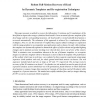Free Online Productivity Tools
i2Speak
i2Symbol
i2OCR
iTex2Img
iWeb2Print
iWeb2Shot
i2Type
iPdf2Split
iPdf2Merge
i2Bopomofo
i2Arabic
i2Style
i2Image
i2PDF
iLatex2Rtf
Sci2ools
118
Voted
FGR
2002
IEEE
2002
IEEE
Robust Full-Motion Recovery of Head by Dynamic Templates and Re-Registration Techniques
This paper presents a method to recover the full-motion (3 rotations and 3 translations) of the head from an input video using a cylindrical head model. Given an initial reference template of the head image and the corresponding head pose, the head model is created and full head motion is recovered automatically. The robustness of the approach is achieved by a combination of three techniques. First, we use the iteratively re-weighted least squares (IRLS) technique in conjunction with the image gradient to accommodate non-rigid motion and occlusion. Second, while tracking, the templates are dynamically updated to diminish the effects of self-occlusion and gradual lighting changes and to maintain accurate tracking even when the face moves out of view of the camera. Third, to minimize error accumulation inherent in the use of dynamic templates, we re-register images to a reference template whenever head pose is close to that in the template. The performance of the method, which runs in r...
Biometrics | FGR 2002 | Head Model | Head Motion | Head Pose |
| Added | 14 Jul 2010 |
| Updated | 14 Jul 2010 |
| Type | Conference |
| Year | 2002 |
| Where | FGR |
| Authors | Jing Xiao, Takeo Kanade, Jeffrey F. Cohn |
Comments (0)

